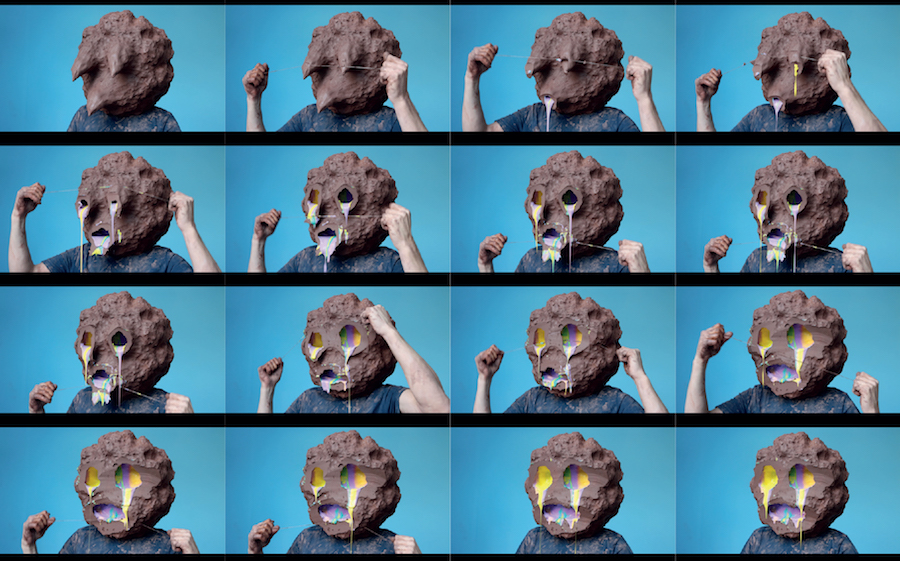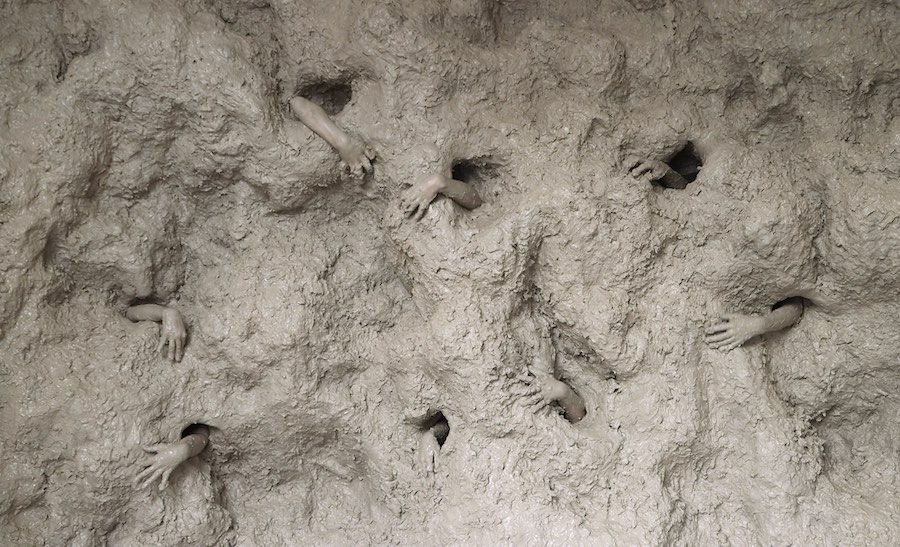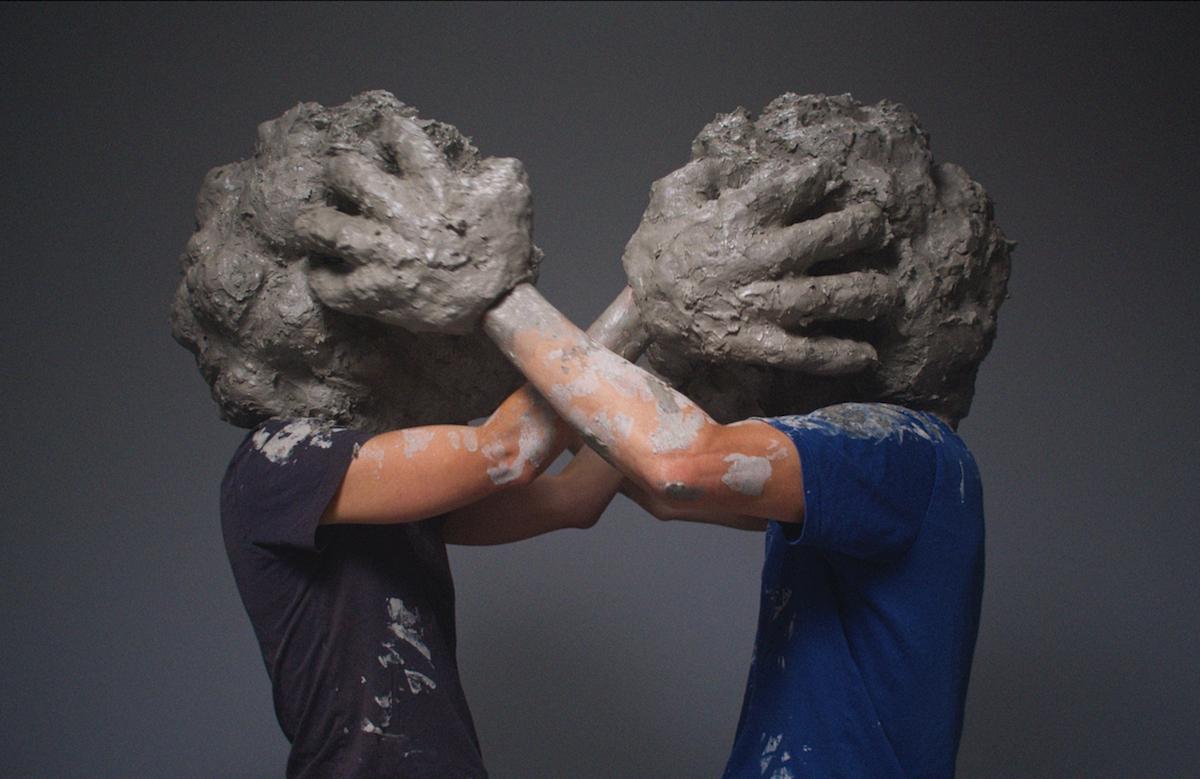William Cobbing has three shows opening in September: he’s in the group shows ‘After the Performance’ (with the film ‘screensaver’ at Tension Fine Art, Penge 7-30 Sept) and ‘Full House’ (ceramics including ‘Float’, presented by Canopy Collections at Cromwell Place, South Kensington 14 Sept – 1 Oct) and has a solo show at Airspace Gallery as part of the British Ceramics Biennial in Stoke (23 Sept – 5 Nov), with a series of new videos, sculpture, and performance, exploring a playful and ambiguous interaction between people immersed in mounds of formless clay. ‘These earth-clad people, says the press release, ‘are caught in an ouroboros loop of transforming themselves’ and ‘individual identity is effaced, with the protagonists becoming hybrid forms somewhere between themselves and the material’. It seemed a good time to talk…

‘Will.ni.naiz’, 2022 – video stills
PCK: You might say that clay is foregrounded in your work performatively, in a more radical way than just using it to make ceramics. What’s the appeal?
WC: It’s the clayiness, the clagginess, the tactility, the squelchyness of clay I like to work with before it turns into beautifully honed pots. I’ve been reading Petra Lange-Berndt’s catalogue essay for the exhibition I was in: ‘Further Thoughts on Earthy Materials’ at Kunsthaus Hamburg. She examines creation myths, as in the bible, in which clay is a passive material that gets shaped and always with a gendered contract that man has autonomy over the material. She looks at the feminist critique of this, in terms of ‘material’ signifying ‘mother’, subverting Western ideas that material is passive and needs to be conquered, with clay having its own innate qualities, its own personality. That also made Lange-Berndt think of Kazuo Shiraga’s, ‘Challenging Mud’ (1955), in which he wrestled mud with the lovely takeaway line ‘and the earth won’. I’m also interested in the Jewish myth of the Golem, in which once the Golem is formed, a ‘shem’ is put under the tongue, and that gives life to the clay. It’s a mutable myth, but there’s a 1915 film ‘Der Golem’ in which the Golem, created from clay, rampages through the streets, out of control – the myth of decisive agency over material is countered.

Still from ‘screensaver’, 2022
Do you also associate your work with the environmental agenda? ‘screensaver’ might be seen that way?
Yes, ‘screensaver’ shows an expansive clay ground of which we are a part, as opposed to being separate from it. There are no digital interventions: it features four performers, directed by me with no special effects – what you see is what you get. And it suggests that the world can cope without us, in contrast to the humancentric idea that the world in some sense can’t exist beyond us. It can, which is humbling. I also think of how Georges Bataille, in ‘The Big Toe’ (1929) explains that ‘the function of the human foot consists in giving a firm foundation to the erection of which man is so proud (the big toe, ceasing to grasp branches, is applied to the ground on the same plane as the other toes).’ Yet even though the big toe is central to the human as vertical and separate from the earth and looking towards the heavens – we have our feet in the mud…
You could look at ‘screensaver’ as a dark work, as if for example an earthquake has just occurred. But the hands do also seem to be enjoying the clay. How do you see it?
I’m hoping there is ambiguity in all my videos. They elicit a variety of responses from attraction to repulsion – some people find them abject, revolting, nihilistic. Others find them funny. Here I do also see elements of sensuality with the material, and a reference to the process of making – but without the result. That’s a kind of artistic limbo, so ‘screensaver’ deals with the state of limbo.
The single head video works, made with the constraints of lockdown, have been widely viewed online. They strike me as quite painterly, as the colour bleeds out of, for example, ‘Will.ni.naiz’ (as above)
I did start out painting at school, but switched to sculpture soon after starting art college. I don’t paint now, but I loved Auerbach, Bacon and Guston– who use paint in a visceral way. That slicing away of layers isn’t quite destructive – people saw it as ‘peeling back into the self’.

‘Float XL’, 2023
The ceramic ‘Float XL’ relates to the solo videos?
Yes, it came out of modelling clay on my head, but has a kind of impossibility. I sometimes try to maximise the qualities of each medium, and you can’t separate head and body on film! It’s wanting to draw attention to this poor guy with a clay mass ball for a head. Materiality in sculpture is often about heaviness and gravity, and this is evading the normal physical constraints. The videos are referenced, playing jokily between the rough and smooth clay, by the more realistically sculpted arms. I made this on a residency at the European Ceramics Centre (EKWC) in Oisterwijk, The Netherlands, where I had the chance to work with top technicians. That enabled me to experiment with different effects on clay – the arms use a Chinese celadon glaze, a semi-translucent pale green; the rougher parts are sprayed with an underglaze.
‘Float XL’ might also suggest carrying a rock?
That fits with a view I have of the video heads as a whole as picking up on a possible interpretation of Camus’s ‘The Myth of Sisyphus’ (1942). Sisyphus, in ancient Greek myth, was condemned to repeat forever the same meaningless task of pushing a boulder up a mountain, only to see it roll down again. Yet Camus concludes: ‘the struggle itself towards the heights is enough to fill a man’s heart. One must imagine Sisyphus happy.’ A daily repeated routine can give a sense of meaning, as opposed to seeing that only in the achievement of a final objective. Being engaged in a process can be engrossing.
Top Photo: Still from work-in-progress (2023)
You will be showing eight new films in an immersive installation in the appropriate location of Stoke, the historic home of the ceramics industry. Like ‘screensaver’, they feature more than one performer, as indicated by the exhibition title ‘Social Substance’. What are they about?
They return to my pre-lockdown consideration of inter-relationships, and what happen when communication – or miscommunication – occurs. I’m not one for dramatic renderings in my own performances or when directing others: I try to keep actions very rudimentary, almost underperformed, deadpan – with the idea of pulling back, allowing the clay to have more of a say. And almost like an animal movement, here perhaps a bear with big paws.
The performers’ senses are restricted. How does that play out?
I want to think of actions that put obstacles in the way, slow down the movements, and make us think about the restriction of senses, especially on sight. And there’s a difference between viewing the films and experiencing them as a performer. The performances are short enough not to be too claustrophobic, and it becomes quite meditative when you can’t see. The attention given to sight, which tends to be seen as primary, reduces and you then get an increased awareness of touch and hearing – the pecking order of the senses is changed. I’m happy that some people will think it looks horrendous and suffocating while others see it as meditative and sensuous as well as abject. And it’s physical, slapstick humour. People have a particular taste for humour, so not everyone will find them funny, but I see humour as a lubricant to help process more difficult emotions.
You can follow William Cobbing’s work via his Instagram @william.cobbing. His three shows are at Tension Fine Art, Canopy Collections at Cromwell Place , and Airspace Gallery.

